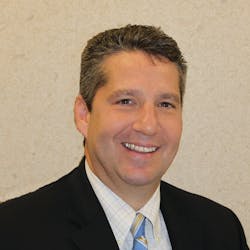Each year at the annual HIMSS (Healthcare Information and Management Systems Society) conference, new trends emerge as the hottest topics of the year, leading to standing-room-only panel sessions focused on particular technology breakthroughs or policy pronouncements from regulators.
This year, as health technology executives and entrepreneurs prepare to descend upon Orlando, Fla., from Feb. 11-15, for the week-long HIMSS19, topics ranging from interoperability to disruption by big tech firms are drawing interest.
Michael Restuccia, senior vice president and chief information officer for Penn Medicine in Philadelphia, has three items on his to-do list for HIMSS. The first is to try to figure out what new entrants from other industries plan to do in healthcare IT. “I am curious about all these cross-sector and big-tech collaborations are doing now that they have jumped into healthcare,” he says. “What is going on with Amazon, Berkshire and JP Morgan? What is CVS doing? Everyone seems to think it is so easy to jump into healthcare and make a difference. I would be curious about what they are doing that is tangible, not pie in the sky. What should I be aware of to help Penn Medicine advance?”
Restuccia also is keeping his eye out for innovations that might make it easier for clinicians to visualize the information they need from the EHR (electronic health record). “Are there tools out there that are going to help end-users better visualize the data in our EHR in their workflow process?” he asks. “It would help in terms of driving optimization and value out of our EHR if they could drill down easily and see data specific to their patient.”
Will FHIR Remain Hot This Year?
At the last few HIMSS conferences, one of the hottest topics has been HL7 FHIR’s potential to solve some nagging interoperability problems. But with FHIR (Fast Healthcare Interoperability Resources) starting to become a little less novel, will it still be the talk of Orlando?
“We won’t know until we get there,” says Wayne Kubick, the nonprofit HL7’s chief technology officer, “but I think the good news is that FHIR has now become an accepted part of the ecosystem,” and he adds that this is a pivotal moment for FHIR. Why? Because FHIR Release 4 was published at the end of 2018, and that has the first normative content. “Then no longer can people say it is just a draft for trial use,” he says. “That plus the 2019 mandate to make patient-focused APIs (application programming interfaces) available from providers are two pretty big events around FHIR. Will that bring a lot of people to hear about it at HIMSS? I don’t know, but I suspect that there will be FHIR in a lot of sessions in different capacities across the conference. FHIR should be part of all the other topics people are presenting on.”
Because he used to be CTO of the Clinical Data Interchange Standards Consortium (CDISC), Kubick also is keenly interested in clinical research and will be interested in hearing about mobile digital health advances at HIMSS. “I think the whole patient engagement and digital health theme is starting to mature with the release of the Apple Health Kit,” he says. “That is going to open up an entire range of opportunities for things we didn’t think of before. If patients engaged in clinical trials can authorize and share their data, that can help the research space quite a bit.”
Innovations in Applied Machine Learning
Executives from the Duke Institute for Health Innovation (DIHI) presented about their work applying machine learning to population health challenges at last year’s HIMSS conference in Las Vegas and were asked for their advice about panels this year.
“My feedback was that I wanted to hear about more examples of what it actually looks like when you are implementing these things,” says Mark Sendak, M.D., DIHI’s population health and data science lead. “There are lots of great presentations about work being done in AI and machine learning, but it is harder to find really good use cases with models developed and put to use in local settings. That is something we at Duke have focused on over the last several years. I am excited because HIMSS was very receptive to that feedback and has been very intentional in putting together a panel of organizations doing the hard work of putting infrastructure in place and a team together.” Sendak will be moderating a panel on Monday, Feb. 11, on “Healthcare’s Innovation Challenge.”
Suresh Balu, associate dean for innovation and partnership for the Duke School of Medicine and program director for DIHI, said he also is looking forward to hearing about other examples of how machine learning and AI can help with value-based care initiatives. “It boils down to looking at voluminous amounts of data so we can risk-stratify patients,” he explains. “Decisions are made at transitions of care. If you can risk-stratify patients prior to the transition point, you can make sure the care is delivered at the right time to the right person and improves outcomes.”
Following Interoperability Policy Changes
Dan Paoletti is CEO of the nonprofit Ohio Health Information Partnership, which manages the CliniSync statewide health information exchange (HIE). His focus at HIMSS will be all things interoperability. First, he is giving a presentation about the Partnership’s work titled: “How to streamline cross-continuum data for greater usability.” His talk will focus on the journey the Partnership has been on to make all the data available to clinicians through the HIE more user friendly at the bedside. “We are taking the information coming in about a patient, normalizing it, standardizing it and repackaging it in a chronological order and then presenting it back to clinicians in a way they can use it,” he says.
Paoletti also is looking forward to learning more about regulatory changes that may impact his organization’s stakeholders. There will be new rules around information blocking, TEFCA (the Trusted Exchange Framework and Common Agreement) and proposed changes to HIPAA to be discussed. “We also are looking for additional information on how FHIR and blockchain are being used,” he adds, “and APIs are going to be important in interoperability efforts and patient access to data.”
He and his team spend weeks carefully orchestrating their schedules for HIMSS. “The week that I spend there saves me weeks, if not months, of travel and effort,” he explains, “so strategically setting up those meetings and identifying the educational sessions we want to go to is crucial. It is like a chess match. We are on the go from 6:30 in the morning until late at night. It is a pretty packed schedule.”
A Focus on Nursing Innovation
Something new at HIMSS this year will be a “NursePitch” event, the result of a collaboration between the American Nurses Association (ANA) and HIMSS. The inaugural Shark Tank-like event will take place Wednesday, Feb. 13, with monetary, mentorship, recognition and membership prizes.
“Nurses are natural innovators, but sometimes they don’t see themselves that way,” says Bonnie Clipper, R.N., the ANA’s vice president of innovation. “We are trying to change that lens and develop business skills in a meaningful way.”
Nurse-led teams will pitch their business ideas and demonstrate prototypes, she says. “You have to do a market assessment, define the problem you are going to solve, show us there is a market willing to pay for it, who the competitors are in the marketplace and why this is better or filling a niche no one else has been able to fill yet,” she explains. “The purpose is to cultivate this skill set in nurses.”
The first-place prize is $10,000; second place $5,000; and third place $2,500.
What types of panel sessions will Clipper be interested in attending at HIMSS? “In the nursing world, the more we can learn about artificial or augmented intelligence the better,” she says. “I think that is going to be informing the work we do about care models of the future, so that is high on my list.”
Asked about her approach to large conferences such as HIMSS, she says: “I am a planner. I like to know the themes I want to hit ahead of time and make sure I am in the right place to learn as much as I can.”




